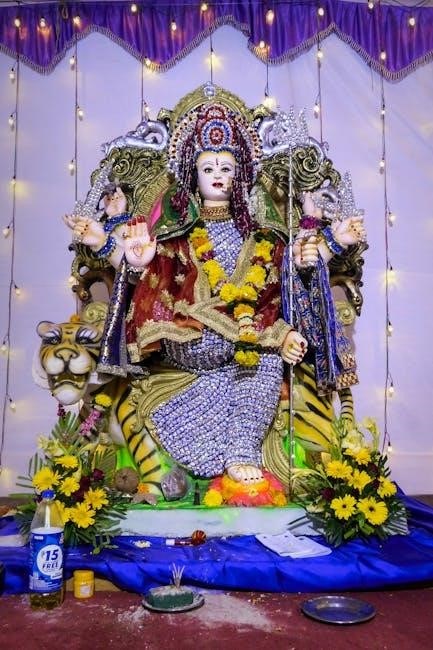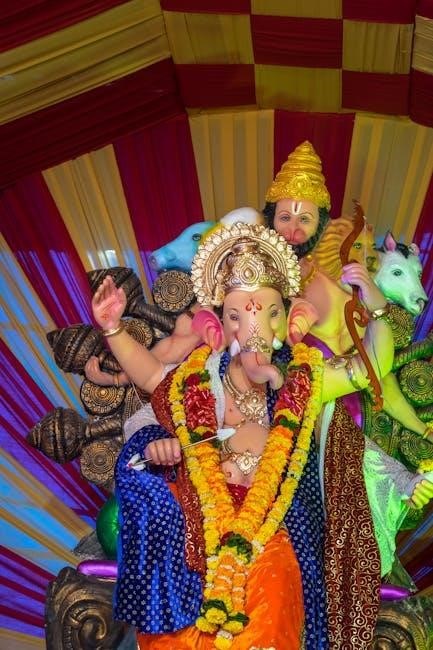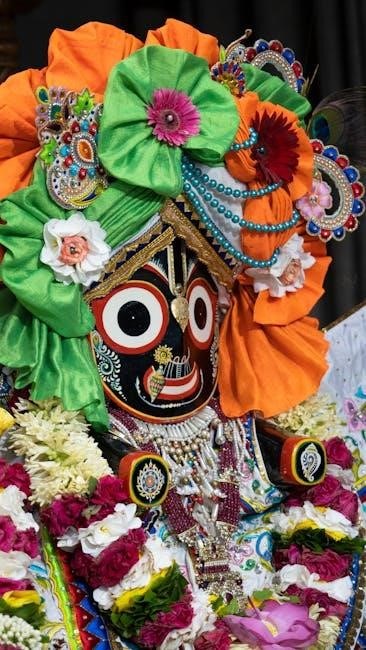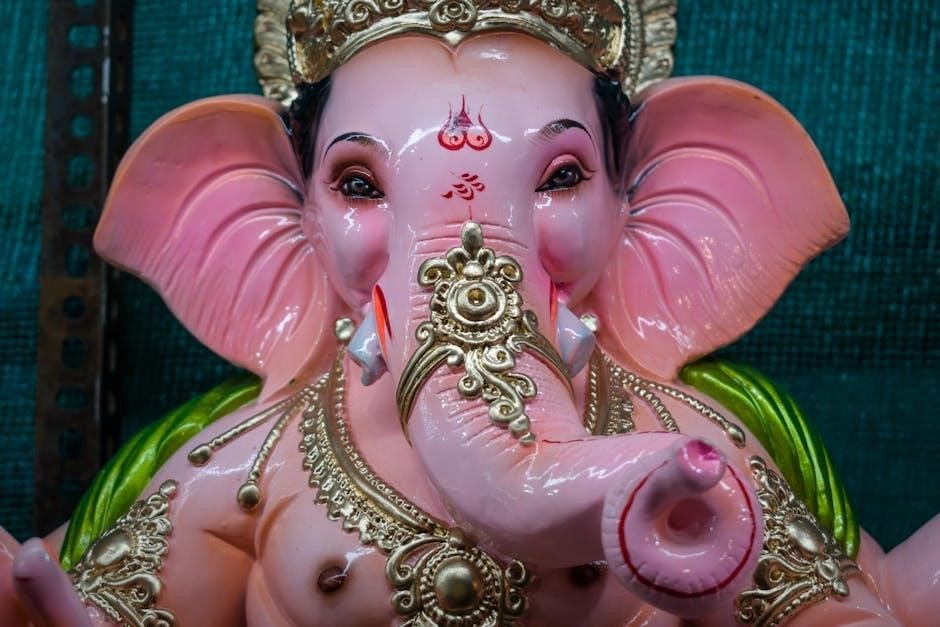Satyanarayana Pooja, a sacred Hindu ritual, honors Lord Vishnu as Satyanarayana. It is performed for prosperity, health, and happiness, often during auspicious occasions like Griha Pravesh and weddings.
1.1 Significance of Satyanarayana Pooja
Satyanarayana Pooja holds immense spiritual and cultural significance in Hinduism. It is a devotion to Lord Vishnu in his Satyanarayana form, embodying truth and righteousness. This pooja is believed to bring prosperity, peace, and fulfillment of desires. It is often performed during auspicious occasions like weddings, housewarming ceremonies, and full moon days. The ritual is considered a powerful means to seek divine blessings for success, health, and happiness. Its significance lies in its ability to ward off obstacles and grant spiritual growth. Many devotees perform it to express gratitude or to achieve specific life goals. The pooja is also a symbol of community bonding, often conducted in the presence of family and friends. Its roots in ancient scriptures make it a timeless and universally revered practice.
1.2 Required Items for Satyanarayana Pooja
To perform Satyanarayana Pooja, specific items are essential for the rituals. These include flowers, fruits, coconuts, milk, sugar, honey, ghee, and beetle leaves. Additionally, turmeric, kumkum, sandal powder, and akshatha (uncooked rice mixed with turmeric) are needed for offerings. A plate with four bowls is required to arrange these items. Fruits should be placed on a separate plate or tray. Panchamrit, a mixture of milk, curd, honey, sugar, and ghee, is a key offering, with a Tulsi leaf added to it. Other items include a puja stool, puja vessels, and coins for distribution. The idol or photo of Satyanarayana is central to the setup. These items ensure the pooja is conducted with purity and adherence to tradition.

Preparation and Setup for Satyanarayana Pooja
Preparation involves arranging a puja stool to the east, placing Satyanarayana’s idol, and organizing items like turmeric, kumkum, and akshatha in bowls. Fruits are displayed on a plate or tray.
2.1 Step-by-Step Preparation Guide
Begin by arranging a puja stool to the east and placing Satyanarayana’s idol or image. Organize items like turmeric, kumkum, and akshatha in separate bowls. Prepare panchamrit by mixing milk, curd, honey, sugar, and ghee, then add tulsi leaves. Arrange fruits and flowers on a plate or tray. Keep coconuts, beetle leaves, and ghee ready. Set up a plate with four bowls for turmeric, kumkum, sandal powder, and akshatha. Ensure all offerings are neatly displayed. Perform a cleansing ritual by sprinkling akshatha around the puja area. Light a lamp and incense to create a sacred ambiance. Complete the setup by keeping prasad and other essentials within reach for the rituals.

2.2 Setting Up the Puja Altar
Setting up the puja altar involves careful arrangement to create a sacred space. Place a puja stool facing east and position the Satyanarayana idol or image centrally. Arrange offerings like flowers, fruits, and coconuts in separate plates or trays. Keep panchamrit, a mixture of milk, curd, honey, sugar, and ghee, in a dedicated vessel with tulsi leaves. Organize turmeric, kumkum, sandal powder, and akshatha in four small bowls on a plate. Place beetle leaves and ghee separately. Light a lamp and incense to purify the environment. Sprinkle akshatha around the altar to sanctify the space. Ensure all items are neatly arranged, reflecting devotion and readiness for the rituals.

The Satyanarayana Pooja Procedure
The Satyanarayana Pooja begins with the invocation of Lord Vishnu, followed by offerings of flowers, fruits, and panchamrit. The ritual includes chanting mantras, reciting Satyanarayana Katha, and distributing prasad.
3.1 Detailed Rituals and Mantras
The Satyanarayana Pooja involves intricate rituals performed with devotion. It begins with Sankalpa, a vow to perform the pooja, followed by Achamana, a purification ritual. The priest or performer chants sacred mantras, including Om Shreem Mahalakshmiyei Namah, while offering flowers, fruits, and Panchamrit (a mixture of milk, curd, honey, sugar, and ghee) to Lord Satyanarayana. The rituals emphasize the recitation of the Satyanarayana Katha, which narrates the essence of truth and devotion. Each step is accompanied by specific Vedic hymns and offerings to deities like Ganesh, Navagraha, and Tulasi. The pooja concludes with the distribution of prasad, symbolizing divine blessings. Adherence to these rituals and mantras ensures the pooja’s spiritual efficacy and fosters a profound connection with the divine.
3.2 The Role of Satyanarayana Katha
Satyanarayana Katha is a sacred narrative central to the pooja, recounting the glory of Lord Satyanarayana. It details the story of Lord Vishnu’s incarnation as Satyanarayana, emphasizing truth, devotion, and righteousness. The Katha is a dialogue between Lord Vishnu and Sage Narada, where Vishnu explains the procedure of the pooja and its benefits. It narrates stories of a merchant and a Brahmin, illustrating the consequences of skipping the Katha during the pooja. The Katha is recited to invoke divine blessings and reinforce moral values. It is a pivotal element, ensuring the pooja’s completion and spiritual significance. Devotees listen to the Katha with reverence, believing it amplifies the pooja’s efficacy and fosters a deeper connection with the divine.

The Importance and Benefits of Satyanarayana Pooja
Satyanarayana Pooja brings peace, prosperity, and spiritual growth. It is believed to fulfill desires, ensure health, and grant divine blessings, making it a revered ritual for devotees seeking harmony and success.
4.1 Spiritual and Material Benefits

Satyanarayana Pooja is believed to bestow both spiritual and material benefits. Spiritually, it cleanses the mind, strengthens faith, and fosters a deeper connection with the divine. Materially, it is said to bring prosperity, wealth, and success, fulfilling desires and resolving life’s challenges. Performing the pooja with sincerity and devotion is thought to grant peace of mind, good health, and harmony in family life. It is also considered a powerful remedy for overcoming obstacles and achieving career growth. The ritual is particularly auspicious for new beginnings, such as starting a business or moving into a new home. By invoking Lord Satyanarayana’s blessings, devotees seek a balanced and fulfilling life, both spiritually and materially.

4.2 Common Mistakes to Avoid
Performing Satyanarayana Pooja requires attention to detail to avoid common mistakes. Skipping essential steps, such as the Satyanarayana Katha or failing to offer Panchamrit, can reduce the ritual’s effectiveness. Incorrect preparation of items, like not mixing Akshatha properly or using impure substances, is also a mistake. Ignoring the prescribed sequence of offerings or mantras can disrupt the pooja’s sanctity. Additionally, not maintaining cleanliness and purity during the ritual is considered inauspicious. Devotees should avoid rushing through the procedures and ensure all offerings are made with devotion. Neglecting to fast or failing to distribute prasad appropriately can also diminish the pooja’s benefits. Awareness of these common errors helps in performing the ritual correctly and seeking maximum blessings from Lord Satyanarayana.

Variations and Regional Practices
Satyanarayana Pooja varies across regions, with different traditions and customs. Some communities emphasize specific rituals, while others incorporate local practices, reflecting diverse cultural influences while honoring Lord Satyanarayana.
5.1 Different Traditions Across India
Satyanarayana Pooja is celebrated with diverse traditions across India, reflecting regional cultural influences. In South India, particularly in Andhra Pradesh and Tamil Nadu, the pooja is performed with elaborate rituals, including the recitation of specific mantras and the offering of traditional sweets. In Maharashtra and Gujarat, the ceremony often includes local prayers and the distribution of prasad like ladoos and fruits. Northern regions may incorporate additional deities and regional folklore into the rituals. Despite variations, the core essence of worshipping Lord Satyanarayana remains consistent. These regional practices highlight the adaptability and cultural richness of the pooja, making it a unifying spiritual experience across the country.
Satyanarayana Pooja is a timeless ritual offering spiritual and material blessings. Its universal appeal and profound benefits make it a cherished practice across generations, fostering peace and prosperity.
6.1 FAQs About Satyanarayana Pooja

Q: What is the purpose of Satyanarayana Pooja? It is performed to seek Lord Vishnu’s blessings for prosperity, health, and happiness.
Q: What are the essential items required? Items include fruits, flowers, coconuts, milk, ghee, honey, and beetle leaves.
Q: Can it be done at any time? Yes, but it is most auspicious on full moon days or during special occasions like weddings.
Q: What is the role of Satyanarayana Katha? It narrates stories of Lord Vishnu, emphasizing truth and devotion.
Q: How many people can participate? Ideally, at least four people, including the priest, should be present.
6.2 Downloading the Satyanarayana Pooja PDF Guide
The Satyanarayana Pooja PDF guide is a comprehensive resource detailing rituals, mantras, and procedures for performing the pooja. It includes step-by-step instructions, required items, and the significance of the rituals. The PDF can be downloaded from various sources, such as temple websites or platforms like Scribd. It is often available in multiple languages, including English and Sanskrit, making it accessible to a wide audience. The guide also includes the Satyanarayana Katha, which are sacred stories recited during the pooja. By downloading the PDF, devotees can ensure they perform the pooja correctly and derive its spiritual benefits. It serves as a handy reference for both beginners and experienced performers.